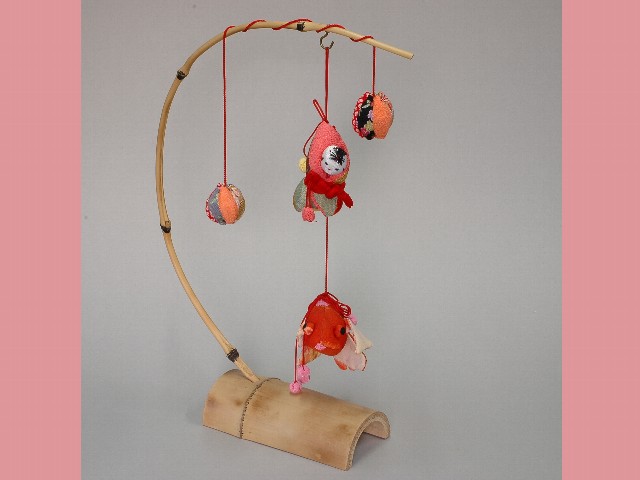So this is part 2 of last weeks post because they will always be tied together in my head – the first time I saw Hina Matsuri dolls and some amazing “Tsurushi Kazari” which are hanging good luck charms and one of Japan’s many cool handicrafts with ancient ties that have survived through the centuries…

These are handmade stuffed animals, dolls and other “lucky” symbols that are hung individually or strung together and hung in mobiles. They can range in size from 1/2 inch to a few inches and sit on a table top or require their own 6 or 7 foot stand. Many are made from the silk of old kimonos or textured fabric. Since they are handmade, it is hard to calculate the value of these handicrafts, but some that I found for sale online have ranged from $40 for a small stand and ornament to thousands of dollars for a tall stand and version.

Here is a link from the same website for a medium sized one with detailed pictures that sells for 190,000 Yen (about $2,000)
One of my students’ mother makes Tsurushi Kazuri and hers sell for more than $3000 for a large sized one and I’m sure they are gorgeous – I’m hoping to see a picture one day.

Families would make these charms to hang, often special ones for the change of seasons or Girls’ Festival to bring luck, health and happiness to their growing daughters and granddaughters. Some believe that this tradition dates back at least 300 years and is only found in certain parts of Japan.

There are apparently more than 140 designs, each with different meanings, prayers and wishes. The ones that I recognized were the cherry blossoms, plum blossoms, other flowers, koi fish among others, birds including cranes, turtles, various balls and pinwheels, etc…
“designs covering everything from wishes for the child to be healthy, have enough money, be happy, be happily married, be protected from insects and smallpox, and not choke on their mother’s milk. Figures include mice and rice sacks, flying babies, sanbasou (visiting deities of home purification), twirling balls of all colors, pink apricots, and bunny rabbits” ~ from a Shizuoka travel site
Another website that referred to the sewed ornaments as “sagemon” says…
These beautiful hand crafted creations have been a part of Japan’s history for over 300 years! Ever since the Edo era, Sagemon have been traditionally created from small bits of kimono cloth and stuffed into various symbolic shapes. For example most Sagemon include chicks (ひょこ) which represents a girl’s cuteness or adorableness, cherry blossoms (桜) representing a girl’s ability to amuse others, rabbits (うさぎ) representing a girl’s maturity, goldfish (金魚) representing a girl’s graceful appearance, and several others. The large balls in the middle of Sagemon are called Yanagawa Mari (柳川毬) and take on various different patterns and sizes. The much smaller ornaments surround the Yanagawa Mari and are normally limited to 51 items. The average lifespan of a Japanese adult in the Edo area when Sagemon were created was 50 years of age. Sagemon are usually sown together by a young girl’s grandmother and presented to her as a child to wish her happiness, good luck, and prosperity.
Those are so neat! You’re going to learn how to make them, right? And teach me when you get home. 🙂
Haha… actually, i was looking at books with patterns in them, but all the instructions are in Japanese so thats not really helpful… but it would be fun to try!
Oliver would love these! His favorite thing is his $5 Ikea Mobile.
I want one for Easton! 🙂